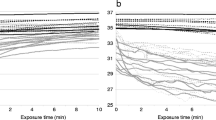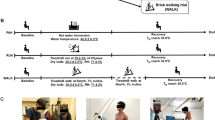Abstract
We aimed to develop a practical method to estimate oesophageal temperature by measuring multi-locational auditory canal temperatures. This method can be applied to prevent heatstroke by simultaneously and continuously monitoring the core temperatures of people working under hot environments. We asked 11 healthy male volunteers to exercise, generating 80 W for 45 min in a climatic chamber set at 24, 32 and 40 °C, at 50% relative humidity. We also exposed the participants to radiation at 32 °C. We continuously measured temperatures at the oesophagus, rectum and three different locations along the external auditory canal. We developed equations for estimating oesophageal temperatures from auditory canal temperatures and compared their fitness and errors. The rectal temperature increased or decreased faster than oesophageal temperature at the start or end of exercise in all conditions. Estimated temperature showed good similarity with oesophageal temperature, and the square of the correlation coefficient of the best fitting model reached 0.904. We observed intermediate values between rectal and oesophageal temperatures during the rest phase. Even under the condition with radiation, estimated oesophageal temperature demonstrated concordant movement with oesophageal temperature at around 0.1 °C overestimation. Our method measured temperatures at three different locations along the external auditory canal. We confirmed that the approach can credibly estimate the oesophageal temperature from 24 to 40 °C for people performing exercise in the same place in a windless environment.










Similar content being viewed by others
References
Amoateng-Adjepong Y, Del Mundo J, Manthous CA (1999) Accuracy of an infrared tympanic thermometer. Chest 115:1002–1005
Basagana X, Escalera-Antezana JP, Dadvand P, Llatje Ò, Barrera-Gómez J, Cunillera J, Medina-Ramón M, Pérez K (2015) High ambient temperatures and risk of motor vehicle crashes in Catalonia, Spain (2000-2011): a time-series analysis. Environ Health Perspect 123:1309–1316. doi:10.1289/ehp.1409223
Benzinger TH (1961) A newly discovered sensory organ in the brain precisely measures the body temperature and trips heat-dissipating mechanisms that maintain the temperature within a fraction of one degree. Sci Am 203:134–147
Benzinger TH (1969) Heat regulation: homeostasis of central temperature in man. Physiol Rev 49:671–759
Brinnel H, Cabanac M (1989) Tympanic temperature is a core temperature in humans. J Therm Biol 14(1):47–53
Cattaneo CG, Frank SM, Hesel TW, El-Rahmany HK, Kim LJ, Tran KM (2000) The accuracy and precision of body temperature monitoring methods during regional and general anesthesia. Anesth Analg 90:938–945
Cheung SS, Lee JK, Oksa J (2016) Thermal stress, human performance, and physical employment standards. Appl Physiol Nutr Metab 41(6 Suppl 2):S148–S164. doi:10.1139/apnm-2015-0518
Childs C, Harrison R, Hodkinson C (1999) Tympanic membrane temperature as a measure of core temperature. Arch Dis Child 80(3):262–266
Cooper KE, Cranston WI, Snell ES (1964) Temperature in the external auditory meatus as an index central temperature changes. J Appl Physiol 19:1032–1035
Cork RC, Vaughan RW, Humphrey LS (1983) Precision and accuracy of intraoperative temperature monitoring. Anesth Analg 62(2):211–214
Darowski A, Weinberg JR, Guz A (1991) Normal rectal, auditory canal, sublingual and axillary temperatures in elderly afebrile patients in a warm environment. Age Ageing 20:113–119
Domitrovich JW, Cuddy JS, Ruby BC (2010) Core-temperature sensor ingestion timing and measurement variability. J Athl Train 45(6):594–600
Edge G, Morgan M (1993) The genius infrared tympanic thermometer. Anaesthesia 48:604–607
Farnell S, Maxwell L, Tan S, Rhodes A (2005) Temperature measurement: comparison of non-invasive methods used in adult critical care. J Clin Nursing 14:632–639
Fraden J, Lackey RP (1991) Estimation of body sites temperatures from tympanic measurements. Clin Paediatr 30(suppl):65–70
Fuhrmann CM, Sugg MM, Konrad CE 2nd, Waller A (2016) Impact of extreme heat events on emergency department visits in North Carolina (2007-2011). J Community Health 41(1):146–156
Fuller A, Oosthuyse T, Maloney SK, Mitchell D (1999) Evaluation of miniature data loggers for body temperature measurement during sporting activities. Eur J Appl Physiol Occup Physiol 79:341–346
Gasparrini A, Guo Y, Hashizume M et al (2015) Mortality risk attributable to high and low ambient temperature: a multicountry observational study. Lancet 386(9991):369–375
Glaser J, Lemery J, Rajagopalan B et al (2016) Climate change and the emergent epidemic of CKD from heat stress in rural communities: the case for heat stress nephropathy. Clin J Am Soc Nephrol 11(8):1472–1483
Greenleaf JE, Castle BL (1972) External auditory canal temperature as an estimate of core temperature. J Appl Physiol 32:194–198
Hansen RD, Amos D, Leake B (1996) Infrared tympanic temperature as a predictor of rectal temperature on warm and hot conditions. Aviat Space Environ Med 67:1048–1052
Hess JJ, Saha S, Luber G (2014) Summertime acute heat illness in U.S. emergency departments from 2006 through 2010: analysis of a nationally representative sample. Environ Health Perspect 122(11):1209–1215
International Organization for Standardization (2004) ISO 9886. Evaluation of thermal strain by physiological measurements. International Organization for Standardization (ISO), Geneva
Josseran L, Caillère N, Brun-Ney D, Rottner J, Filleul L, Brucker G, Astagneau R (2009) Syndromic surveillance and heat wave morbidity: a pilot study based on emergency Departments in France. BMC Med Inform Decis Mak 9:14. doi:10.1186/1472-6947-9-14
Kawanami S, Horie S, Inoue J, Yamashita M (2012) Urine temperature as an index for the core temperature of industrial workers in hot or cold environments. Int J Biometeorol 56(6):1025–1031
Keatinge WR, Sloan REG (1973) Measurement of deep body temperature from external auditory canal with servo-controlled heating around ear. J Physiol Lond 234:8–9
Keene T, Brearley M, Bowen B, Walker A (2015) Accuracy of tympanic temperature measurement in firefighters completing a simulated structural firefighting task. Prehosp Disaster Med 30(5):461–465
Kovats RS, Hajat S (2008) Heat stress and public health: a critical review. Annu Rev Public Health 29:41–55
Leon LR, Helwig BG (2010) Heat stroke: role of the systemic inflammatory response. J Appl Physiol 109(6):1980–1988
Low DA, Vu A, Brown M, Davis SL, Keller DM, Levine BD, Crandall CG (2007) Temporal thermometry fails to track body core temperature during heat stress. Med Sci Sports Exerc 39(7):1029–1035
Meehl GA, Tebaldi C (2004) More intense, more frequent, and longer lasting heat waves in the 21st century. Science 305:994–997
Moran DS, Mendal L (2002) Core temperature measurement: methods and current insights. Sports Med 32(14):879–885
Morgans LF, Nunneley SA, Stribley RF (1981) Influence of ambient and core temperatures on auditory canal temperature. Aviat Space Environ Med 52:291–293
Muir IH, Bishop PA, Lomax RG, Green JM (2001) Prediction of rectal temperature from ear canal temperature. Ergonomics 44:962–972
Nagano C, Tsutsui T, Monji K, Sogabe Y, Idota N, Horie S (2010) Technique for continuously monitoring core body temperatures to prevent heat stress disorders in workers engaged in physical labor. J Occup Health 52:167–175
Otte im Kampe E, Kovats S, Hajat S (2016) Impact of high ambient temperature on unintentional injuries in high-income countries: a narrative systematic literature review. BMJ Open 6(2):e010399
Price MJ, Campbell IG (2002) Thermoregulatory responses during prolonged upper-body exercise in cool and warm conditions. J Sports Sci 20:519–527
Spector JT, Krenz J, Rauser E, Bonauto DK (2014) Heat-related illness in Washington state agriculture and forestry sectors. Am J Ind Med 57(8):881–895
Terndrup TE (1992) An appraisal of temperature assessment by infrared emission detection tympanic thermometry. Ann Emerg Med 21:1483–1492
Wallace RF, Kriebel D, Punnett L, Wegman DH, Amoroso PJ (2007) Prior heat illness hospitalization and risk of early death. Environ Res 104:290–295
Yamakoshi T, Matsumura K, Rolfe P, Tanaka N, Yamakoshi Y, Takahashi K (2013) A novel method to detect heat illness under severe conditions by monitoring tympanic temperature. Aviat Space Environ Med 84(7):692–700
Ye X, Wolff R, Yu W, Vaneckova P, Pan X, Tong S (2012) Ambient temperature and morbidity: a review of epidemiological evidence. Environ Health Perspect 120:19–28
Zhen C, Xia Z, Long L, Pu Y (2014) Accuracy of infrared ear thermometry in children: a meta-analysis and systematic review. Clin Pediatr (Phila) 53(12):1158–1165
Acknowledgements
We thank Mr. Koichi Monji who supported us technically in controlling the artificial chamber.
Author’s contributions
HN, SK, JI and SH contributed to the study design. HN, SK, YI, KS and KA collected data. HN, SK and SH analysed and interpreted the data and drafted the manuscript. Critique of the article for intellectual content was undertaken by HN, SK, JI and SH.
Author information
Authors and Affiliations
Corresponding author
Ethics declarations
Ethical approval
The study protocol was approved by the Ethics Committee of the University of Occupational and Environmental Health, Japan, in 2013. Written informed consent was obtained from all participants.
Rights and permissions
About this article
Cite this article
Nakada, H., Horie, S., Kawanami, S. et al. Development of a method for estimating oesophageal temperature by multi-locational temperature measurement inside the external auditory canal. Int J Biometeorol 61, 1545–1554 (2017). https://doi.org/10.1007/s00484-017-1333-1
Received:
Revised:
Accepted:
Published:
Issue Date:
DOI: https://doi.org/10.1007/s00484-017-1333-1




